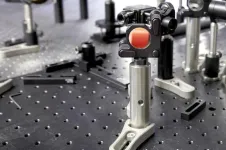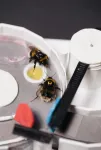(Press-News.org) The mammalian brain is a web of densely interconnected neurons, yet one of the mysteries in neuroscience is how tools that capture relatively few components of brain activity have allowed scientists to predict behavior in mice. It is hard to believe that much of the brain’s complexity is irrelevant background noise. “We wondered why such a redundant and metabolically costly scheme would have evolved,” says Rockefeller’s Alipasha Vaziri.
Now, a new study in Neuron—which presents an unprecedented simultaneous recording of the activity of one million neurons in mice—offers a surprising answer to this fundamental question: technological limitations have misled us, and there’s far more to the brain than once thought.
“Previous assumptions about the true dimensionality of the brain dynamics might have been due the lack of ability to record from sufficiently large number of neurons,” Vaziri says.
Using a custom technique developed in the Vaziri lab, the researchers discovered that more than 90 percent of the dimensions they observed in neural activity (independent components that one needs in order to describe the observed neuronal dynamics that contain signals that are different from noise) were not connected to any spontaneous movements or sensory inputs in the mice studied. Thousands of these dimensions, containing more than half of the cumulative neural activity of the mice, were spread across the brain in space and time, without forming distinct clusters in any one region and ranging in time from minutes to less than seconds.
The mouse was clearly using this thrum of pervasive, continuous activity for some purpose. But for what? “We still don’t know, but it’s definitely a signal that is distinct from noise,” Vaziri says. “It could offer a window into to a variety of complex internal states or neurocomputation.”
Neural flashes
Vaziri’s lab focuses on the development of optical technologies to advance neuroscience and allow observations of the simultaneous activity of many neurons distributed across the brain. In 2021 the lab developed light-beads microscopy, a two-photon imaging technique that uniquely enabled a 100-fold increase in the number of neurons that could be simultaneously recorded. Putting the technology to the test, the researchers recorded the activity of more than one million neurons across the entire cortex of the mouse brain for the first time while animals were observed by multiple cameras from different angles as they were engaged in spontaneous and uninstructed behaviors, such as running on a treadmill or grooming.
Having demonstrated the efficacy of the tool, the lab became interested in using it to address fundamental questions in neurobiology. “We had a tool that could allow us to make discoveries that other technologies could not,” Vaziri says. “So we tried to ask questions that only such a tool could answer. To wit: how much more information are we extracting as we keep recording from more and more neurons, and what does that information represent?”
To investigate, the researchers used LBM in combination with advanced data analysis, computational modeling, and machine learning techniques to study the neural activity of mice as they spontaneously moved and reacted to their environment.
The missing 90 percent
Neural activity linked to animal movements was known to be streamlined into a low-dimensional subspace, allowing previous techniques, which could record fewer neurons, to identify these connections. “However, it was only thanks to LBM’s capability that we could discover that more than 90 percent of the remaining dimensions contained reliable signals that were distinct from noise, not required for behavior and not explained by environmental stimuli.” Vaziri says.
Unexpectedly, these neurons were also firing everywhere. “What are they doing? We don’t know,” Vaziri says. “They may underlie a brain-wide network of correlated neural fluctuations, perhaps related to some sort of internal state dynamics such as hunger or motivation.”
How this may apply to the human brain is still far from settled (“the human brain is an ocean compared to the pond of a mouse brain,” Vaziri says) but the findings strongly suggest that we are only beginning to understand the true complexity of the mammalian brain.
A new kind of observatory
LBM is one of the key instruments that will find a home in the Rockefeller Brain Observatory, a new initiative spearheaded by Vaziri to make pioneering, commercially unavailable instruments accessible to neuroscientists “that can do things that are otherwise impossible,” Vaziri says.
The facility is akin to an astronomical observatory, where visiting scientists will be able to conduct research on powerful instruments. “The idea is that people will be supported by staff as they conduct research using the microscopes in the center,” he says. “It’s something we want to open up to the community within Rockefeller but also to neuroscientists from around the world.”
Vaziri and his team are also helping researchers at several universities, including at Stanford University and UCL-London, replicate LBM technology in their own neuroscience labs. The data they’ve amassed from the current study is also available for analysis by other researchers.
They’re also hoping to increase the range of LBM’s applicability. “For example, we’d like to welcome research groups that work with different model systems beyond mice—insects, nonhuman primates and so on—so we need to have versions of LBM that are more versatile, robust, and user friendly,” Vaziri says.
END
New microscopy tech answers fundamental questions
2024-03-06
ELSE PRESS RELEASES FROM THIS DATE:
Moffitt’s Dr. Tiffany Carson joins Global Cancer Grand Challenges team to tackle cancer inequities
2024-03-06
TAMPA, Fla. — An international interdisciplinary team of researchers, including Moffitt Cancer Center’s Tiffany Carson, Ph.D., has been selected to receive a Cancer Grand Challenges award. Co-founded by the National Cancer Institute and Cancer Research UK, Cancer Grand Challenges supports a community of diverse, global teams to come together, think differently and take on some of cancer’s toughest challenges.
Carson is part of the SAMBAI (Societal, Ancestry, Molecular and Biological Analyses of Inequalities) team led by Melissa Davis, Ph.D., from Morehouse School of Medicine. The team will receive up to $25 million over the next five ...
Cancer Grand Challenges selects five new global, interdisciplinary teams to take on four challenges
2024-03-06
Cancer Grand Challenges has selected five new global research teams that will address the following challenges in cancer: reducing cancer inequities, understanding the mechanisms of early-onset cancers, developing drugs for solid tumors in children, and broadening our knowledge about how T cells recognize cancer cells. The winning teams were announced at the Cancer Grand Challenges Summit on March 6, 2024, in London.
Cancer Grand Challenges is a global funding initiative cofounded in 2020 by the National Cancer Institute (NCI), ...
25 million US dollars for International Cancer Research
2024-03-06
The team is co-led by Martin Eilers, Chair of Biochemistry and Molecular Biology at the University of Würzburg (JMU). “Our research project is called KOODAC,” he explains. “That stands for ‘Knocking-Out Oncogenic Drivers and Curing Childhood Cancer’”. Our goal is to develop well-tolerated drugs that can target and eliminate cancer cells in children.” The current standard of care for childhood cancer is chemotherapy and radiation therapy, which, even when successful, are associated with severe side effects. “These ...
3D reflector microchips could speed development of 6G wireless
2024-03-06
ITHACA, N.Y. – Cornell University researchers have developed a semiconductor chip that will enable ever-smaller devices to operate at the higher frequencies needed for future 6G communication technology.
The next generation of wireless communication not only requires greater bandwidth at higher frequencies – it also needs a little extra time. The new chip adds a necessary time delay so signals sent across multiple arrays can align at a single point in space-- without disintegrating.
The team’s paper, ...
Adverse childhood experiences and adult mental health outcomes
2024-03-06
About The Study: The results of this study using twin data support an association between adverse childhood experiences and poor mental health in adulthood, notwithstanding evidence for familial confounding from shared genetic and environmental factors. These findings suggest that targeted interventions may be associated with reduced risks of future psychopathology.
Authors: Hilda Björk Daníelsdóttir, M.Sc., of the University of Iceland in Reykjavík, Iceland, is the corresponding author.
To access the embargoed ...
Symptoms of cognitive impairment among children with atopic dermatitis
2024-03-06
About The Study: The findings of this study suggest that pediatric atopic dermatitis (AD) was generally associated with greater odds of reported difficulties in learning and memory. However, this association was primarily limited to children with neurodevelopmental comorbidities, such as attention-deficit/hyperactivity disorder or learning disabilities. These results may improve the risk stratification of children with AD for cognitive impairments and suggest that evaluation for cognitive difficulties should be prioritized among children with AD and neurodevelopmental disorders.
Authors: Joy ...
Charge fractionalisation observed spectroscopically
2024-03-06
A research team led by the Paul Scherrer Institute has spectroscopically observed fractionalisation of electronic charge in an iron-based metallic ferromagnet. Experimental observation of the phenomenon is not only of fundamental importance. Since it appears in an alloy of common metals at accessible temperatures, it holds potential for future exploitation in electronic devices. The discovery is published in the journal Nature.
Basic quantum mechanics tells us that the fundamental unit of charge is unbreakable: the electron charge is quantised. Yet, we have come to understand that exceptions exist. In some situations, ...
Bee-2-Bee influencing: Bees master complex tasks through social interaction
2024-03-06
In a groundbreaking discovery, bumblebees have been shown to possess a previously unseen level of cognitive sophistication. A new study, published in Nature, reveals that these fuzzy pollinators can learn complex, multi-step tasks through social interaction, even if they cannot figure them out on their own. This challenges the long-held belief that such advanced social learning is unique to humans, and even hints at the presence of key elements of cumulative culture in these insects.
Led by Dr Alice Bridges and Professor Lars Chittka , the research team designed a two-step puzzle box requiring ...
New study may broaden the picture of the consequences of childhood adversity
2024-03-06
A research team has examined the link between adverse childhood experiences and the risk of mental health problems later in life, according to a study in JAMA Psychiatry. The researchers from Karolinska Institutet and University of Iceland have found that the risk of suffering from mental illness later in life among those experiencing significant adversity in childhood can be partly explained by factors shared by family members, such as genetics and environment.
Several previous studies have shown that people who have experienced ...
Revealing the evolutionary origin of genomic imprinting
2024-03-06
Some of our genes can be expressed or silenced depending on whether we inherited them from our mother or our father. The mechanism behind this phenomenon, known as genomic imprinting, is determined by DNA modifications during egg and sperm production. The Burga Lab at the Institute of Molecular Biotechnology (IMBA) of the Austrian Academy of Sciences uncovered a novel gene regulation process, associated with the silencing of selfish genes, that could represent the first step in the evolution of imprinting. Their discovery, reported in Nature, ...





